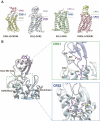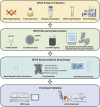Progress in structure-based drug development targeting chemokine receptors
- PMID: 40552145
- PMCID: PMC12183272
- DOI: 10.3389/fphar.2025.1603950
Progress in structure-based drug development targeting chemokine receptors
Abstract
As a critical subfamily of G protein-coupled receptors (GPCRs), chemokine receptors (CCRs) play pivotal regulatory roles in immune cell migration, inflammatory modulation, tissue regeneration, and tumor microenvironment (TME) remodeling. By specifically recognizing chemokine ligands, CCRs orchestrate immune cell trafficking and tissue positioning, with functional dysregulation implicated in infectious diseases, autoimmune disorders, neurodegenerative pathologies, and cancer. These receptors thus represent promising therapeutic targets. Recent breakthroughs in cryo-electron microscopy (cryo-EM) and computational chemistry have enabled high-resolution structural analysis and dynamic conformational modeling of CCRs, establishing a robust foundation for structure-based drug design (SBDD). This review synthesizes current advances in CCR biology, structural mechanisms, disease involvement, and targeted drug development, providing theoretical insights and technical frameworks for future research.
Keywords: CCRs; GPCR; cryo-EM; drug discovery; structure-based drug design (SBDD).
Copyright © 2025 Wang, Qu, Xiao, Liu, Sun and Ping.
Conflict of interest statement
The authors declare that the research was conducted in the absence of any commercial or financial relationships that could be construed as a potential conflict of interest.
Figures






Similar articles
-
Deciphering Shared Gene Signatures and Immune Infiltration Characteristics Between Gestational Diabetes Mellitus and Preeclampsia by Integrated Bioinformatics Analysis and Machine Learning.Reprod Sci. 2025 Jun;32(6):1886-1904. doi: 10.1007/s43032-025-01847-1. Epub 2025 May 15. Reprod Sci. 2025. PMID: 40374866
-
Systemic pharmacological treatments for chronic plaque psoriasis: a network meta-analysis.Cochrane Database Syst Rev. 2021 Apr 19;4(4):CD011535. doi: 10.1002/14651858.CD011535.pub4. Cochrane Database Syst Rev. 2021. Update in: Cochrane Database Syst Rev. 2022 May 23;5:CD011535. doi: 10.1002/14651858.CD011535.pub5. PMID: 33871055 Free PMC article. Updated.
-
Designing Structure-specific and Switchable Allosteric Effectors for GPCRs Based on the Causality and Energetics of Inherent Signaling.J Mol Biol. 2025 Jun 11:169293. doi: 10.1016/j.jmb.2025.169293. Online ahead of print. J Mol Biol. 2025. PMID: 40513649
-
Structure determination of GPCRs: cryo-EM compared with X-ray crystallography.Biochem Soc Trans. 2021 Nov 1;49(5):2345-2355. doi: 10.1042/BST20210431. Biochem Soc Trans. 2021. PMID: 34581758 Free PMC article. Review.
-
Conformational Plasticity of Interleukin-8 Mediates Its Dynamic Molecular Interaction with Potent Inhibitor Suramin.J Chem Inf Model. 2025 Jun 23;65(12):6114-6128. doi: 10.1021/acs.jcim.5c00260. Epub 2025 May 30. J Chem Inf Model. 2025. PMID: 40448032
References
-
- Agresti N., Lalezari J. P., Amodeo P. P., Mody K., Mosher S. F., Seethamraju H., et al. (2021). Disruption of CCR5 signaling to treat COVID-19-associated cytokine storm: case series of four critically ill patients treated with leronlimab. J. Transl. Autoimmun. 4, 100083. 10.1016/j.jtauto.2021.100083 - DOI - PMC - PubMed
Publication types
LinkOut - more resources
Full Text Sources
Research Materials

